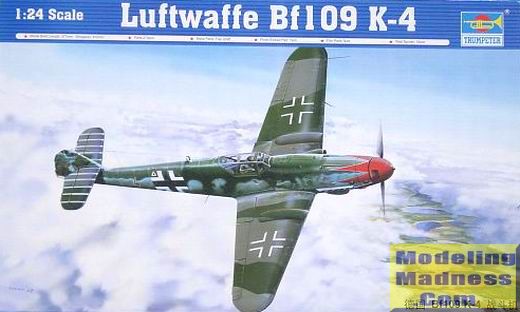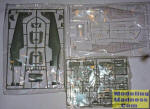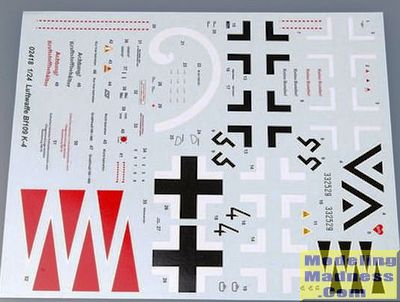
Trumpeter 1/24 Bf-109K-4
| KIT #: | 02418 |
| PRICE: | $86.00 |
| DECALS: | Two options |
| REVIEWER: | Francisco Santoro |
| NOTES: | Sprigs, rubber tires, photoetched parts, metal shafts, FILM for the instrument panel, underwing stores to supposedly build the Bf 109K-6 heavy fighter. |

| HISTORY |
From the reference book: The Bf 109K series were planned as a standarised type that could be built faster than the plethora of variants and subvariants that had characterised the Bf 109G series. The type was based on the airframe of the Bf 109G-10 with the Galland Hood, and included as standard some of the progressive changes that had been introduced in that subvariant as Umrüst Bausastze (factory conversion sets) together with a number of aerodynamic improvements that were individualy small but collectively significant. The first Bf 109K-0 pre-production aircraft appeared in September 1944 to a basic design that differed from that of the Bf 109G-10 most noticeably in the raised line of its cowling, longer spinner for the propeller, a larger inset rudder tab supplemented by a large trailing tab, replacement of the two fuselage mounted 13mm MG 131 machineguns by two 15mm MG 151 cannon to supplement the engine mounted 30mm MK 108 cannon as the fixed forward firing weapon, and a powerplant of one DB 605DB inverted V piston engine with GM-1 nitrous oxide power boost system. Operational trials with these pre-production aircraft revealed no major deficiencies, so the type was authorised for production as the Bf 109K-2, with a powerplant of either one DB 605ASCM engine or one DB 605DCM engine with the GM-1 power boost system.
The Bf 109K-4, in its original form, differed from the Bf 109K-2 only in having a pressurised cockpit, but later examples were revised with the 30mm MK 103 cannon in place of the MK 108 weapon of the same calibre in the engine-cannon installation.
The details of the Bf 109K-4 included an armament of one 30 MK 103 or MK 108 fixed forward firing cannon with 60 rounds in an engine-cannon installation, and two 15mm MG 151/15 fixed forward firing cannons with 220 rounds per gun in the upper part of the of the forward fuselage with synchronisation equipment to fire through the propeller disc, and up to 250kg of disposable stores carried on one hardpoint under the fuselage, powerplant of one DB 605ASCM inverted V piston engine rated at 2000hp for take off and 1800hp at 5000m, internal fuel capacity of 400 litres, external fuel capacity of 300 litres in one droptank, span of 9,97m, an area of 16,10 square metres, length of 8,85m height of 2,50m, empty weight of 2380kg, normal take off weight of 3375kg, maximum take off weight of 3600kg, maximum level speed of 700km/h, declining to 608km/h at sea level, typical range of 573km, maximum rate of climb at sea level of 1469m per minute, climb to 5000m in 3 minutes and a service ceiling of 12500m.
The Bf 109K-6 was the heavy fighter version of the Bf 109K-4 intended for the anti bomber role, with an armament of one 30mm MK 103 cannon in the engine -cannon installation, two 13mm MG 131 machineguns un the uppert part of the forward fuselage, and two 30mm MK 103 cannons in underwing gondolas. The Bf 109K-6 had a maximum take off weight of 3595kg and was distinctly unwieldy in the air, so it is perhaps fortunate for German fighter pilots that relatively few of the type were delivered after its service debut in January 1945.
From Wikipedia: "...apparently all of the K-4s supplied to III./JG 26 were also equipped with 20 mm-guns in the hated underwing tubs. Uffz. Georg Genth's regular aircraft was a G-10, but on occasion he flew a K-4. He preferred the G-10 as a dogfighter, as the K-4's bulky armament sharply reduced its manouevrability."
| THE KIT |
 After
opening the rather large top opening box, decorated with what it is, in my
opinion, a good rendering of the Bf 109K-4 "Black 4" flying over the clouds, the
modeler is presented with twelve sprues, ten of them in light grey and two clear
parts.
After
opening the rather large top opening box, decorated with what it is, in my
opinion, a good rendering of the Bf 109K-4 "Black 4" flying over the clouds, the
modeler is presented with twelve sprues, ten of them in light grey and two clear
parts.
The kit is comprised of 274 pieces, less than those from Trumpeter´s Me 262, which are 355. The kit doesn´t have photoetched parts for the seat belts, in combination with metallic shafts, it has them for the movable flaps, ailerons and rudder, though you can glue them in any position you like.
Also, the kit has springs to use alongside the metal shafts, to give the finished kit a loaded appearence, just as the real plane.
Something which I didn´t know how it was called, which was in my preview of the Fw 190D-9 1:24 from Trumpeter, is a FILM made instrument panel (you will need to paint the plastic part in which it goes in white).
My kit came with two sets of transparent parts (two canopies, two position lights etc...). and a set of transparent fuselage halves, wings etc...
One thing you might want to check are the underwing cannons, remnants of the other Bf 109Gs in 1:24. From what I found, there were K-4s with these underwing weapons, so:
Fill the open holes in the wings if you don´t want them.
Build a K-4 with the cannons if you find a photo of one.
Make a fictional Bf 109K-6.
None of the above.
 The kit has
two decal options, both are from the late Luftwaffe:
The kit has
two decal options, both are from the late Luftwaffe:
1) Messerschmitt Bf 109K-4 Double Chevron, flown by Erich Hartmann, Stab I/JG52, Deutsch Brod, Czechoslovakia, 1945. It is painted in RLM 04/76/81/82. The black tulips are included in the decals.
2) Messerschmitt Bf 109K-4 "Black (or Green) 4", JG52, painted in RLM 36 (nose cone)/75/76/82, Deutsch Brod, Czechoslovakia, 1945. It is said that these was the final plane flown by Erich Hartmann. It has the Red Tulips in the decals.
| CONCLUSIONS |
The Bf 109K-4 has been well represented in all the scales (accuracy matters aside):
1:72: Heller, AML, Fine Models.
1:48: Revell, Hasegawa, Fujimi.
1:32: Hasegawa, Revell, Trumpeter.
But in 1:24, this is the only one, and since it has a lot of aftermarket decal sheets, it can be made into a rather amazing model by modellers with an average of experience. With a wingspan of 41cm and a length of 37,7cm, you can build a good fighter wing without taking too much space.
| REFERENCES |
https://en.wikipedia.org/wiki/Messerschmitt_Bf_109_variants#K-4An
Illustrated Data Guide To World War Two Fighters, pages 52 and 53, by Christopher Chant.
Thanks to for the review kit. You can find this kit at your favorite hobby shop or on-line retailer
If you would like your product reviewed fairly and fairly quickly, please contact the editor or see other details in the Note to Contributors.